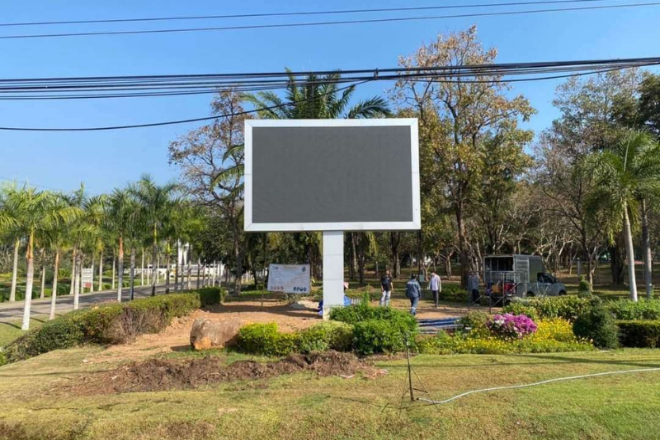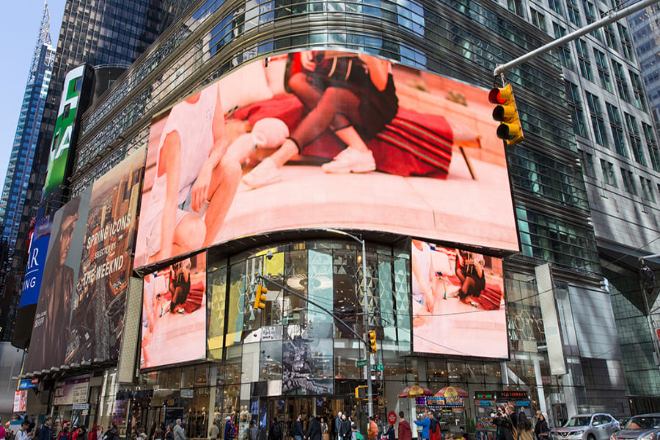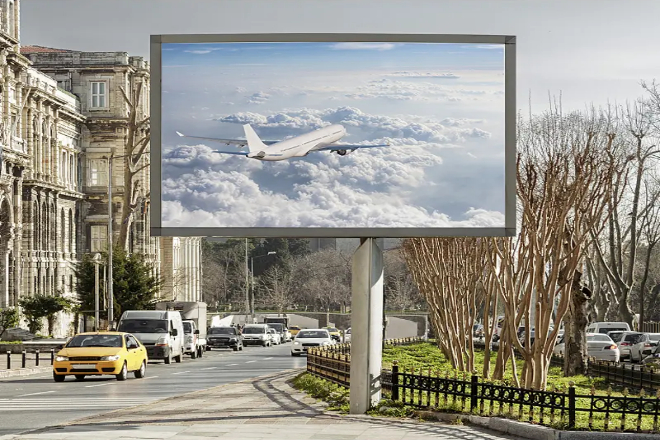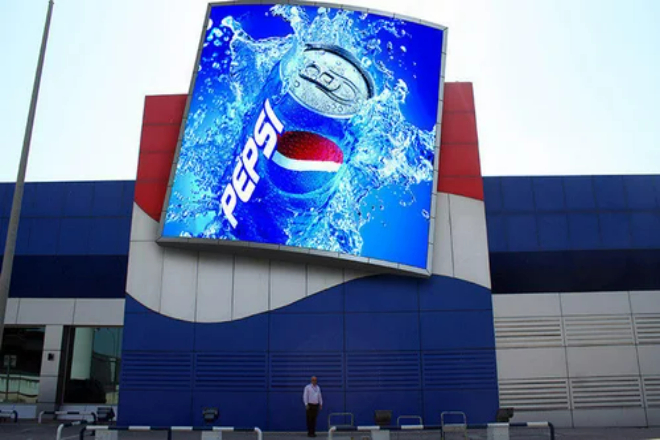介绍

作为现代信息传播的重要工具, 户外LED显示屏 已被广泛应用于各个领域。
但在高海拔地区,面临着低温、低压、高湿、强风、强紫外线等极端气候挑战,如何保证户外LED显示屏在这些恶劣条件下稳定运行?本文告诉你答案。
1、高海拔地区对LED显示屏有哪些影响?

1). 温升与散热问题
- 温升:
随着海拔的升高,空气变得稀薄,空气对流传热的能力减弱,导致LED显示屏内部的温度容易升高。
- 散热困难:
高海拔地区温度通常较低,但LED显示屏工作时会产生热量,由于空气稀薄,自然对流散热效果下降。
如果散热设计不合理,可能会导致显示屏内部温度过高,影响LED灯珠的使用寿命和显示效果。
2). 电气性能下降
- 绝缘性能下降:
高海拔地区空气稀薄,空气密度和绝缘介质强度降低,可能造成LED显示屏绝缘性能下降,增加漏电风险。
- 降低电间隙击穿电压:
随着海拔升高,气压降低,可能造成LED显示屏内部电气间隙击穿电压降低,增大短路风险。
- 电晕和放电现象:
在高海拔、低压环境下,容易产生电晕、放电现象,严重时可能造成显示屏电路系统的损坏。
3). 显示异常
色彩失真:
高海拔地区的气压和温度变化可能会影响LED显示屏的色彩表现,导致色彩失真或屏幕闪烁。
亮度 减少:
随着海拔的升高,空气变得越来越稀薄,可能会造成LED显示屏的亮度下降,影响视觉效果。
4). 物理结构损坏
- 加速材料老化:
高海拔地区紫外线强度较大,长期受紫外线照射会加速LED显示屏外壳及内部电子元件的老化。
- 密封性能下降:
由于内外压差的增大,可能会造成LED显示屏的密封性能下降,灰尘、湿气容易进入显示屏内部,影响其正常工作。
5). 其他影响
- 电压波动:
高海拔地区电源不稳定,电压波动较大,容易造成LED显示屏电路系统的损坏。
- 安装和维护困难:
高海拔地区地形复杂、气候恶劣,对LED显示屏的安装和维护提出了更高的要求。
2、户外LED显示屏应对高海拔地区极端气候的措施

1).防雨、防水、防潮
1.1).采用模块化设计制作LED显示屏:
- 高防水等级:
确保LED显示屏的模组和箱体达到IP65或者更高的IP68防水等级。
这意味着显示屏可以承受强力水射流和长时间水浸,有效防止湿气侵入内部电路,保证显示屏的正常工作。
- 模块化设计:
模块化设计使得LED显示屏易于拆卸和维修,同时每个模块均可独立防水,也有利于提高防水性能。
1.2).模块灌胶及防水柜:
- 模块灌胶封装:
LED模组内部采用灌胶封装,背面刷胶,增强其防水性能。胶水可以填充模组内部的缝隙,防止湿气渗透。
- 防水柜:
选择密封性好的防水箱体安装LED模组,箱体应采用防水材质,接缝处要加防水橡胶圈密封,保证箱体内部的干燥。
1.3).LED显示屏定期清洁保养:
- 提高散热效率:
定期清理LED显示屏屏幕内外附着的灰尘,可以明显提高屏幕的散热效率。
灰尘会阻碍热量的散发,造成显示屏的温度升高,进而影响其性能和寿命。
- 减少水蒸气附着:
清洁灰尘还可以减少水汽的附着,防止因潮湿引起的故障。在高湿度的环境中,水汽很容易凝结在显示屏表面,造成短路或损坏。
2). 抗风、抗震
2.1).选择承重钢结构钢材安装LED显示屏:
根据不同的安装方式(如墙面安装、吊装、屋顶安装、立柱安装等),选择合适的承重钢结构钢材支撑LED显示屏,钢材应具有足够的强度和刚度,以抵抗风荷载和震动。
2.2).严格执行风荷载和抗震标准:
LED显示屏在设计、安装时,必须严格按照风荷载、抗震标准执行。
包括结构强度计算的要求、连接牢固性的检查、减震措施的落实等,确保显示屏在恶劣天气下不会掉落、受损,保证人员和设备的安全。
3).耐高温、散热
3.1).LED显示屏采用宏通设计:
宏透设计可以让LED显示屏内部的热量更加有效的散发出去,同时采用高密度、高精度的电路板,也能减少电路负荷,减少热量的产生。
3.2).保证LED显示屏通风良好:
LED显示屏安装时应保证其所处环境通风良好,必要时可加装空调或风扇等散热设备,以保持显示屏的正常工作温度。
高温会加速LED灯珠的老化,影响显示效果和寿命。
3.3).选择高效率的电源及驱动IC:
高效率的电源及驱动IC可以降低系统的温升,提高LED显示屏的稳定性和可靠性。
选择低功耗、高效率的电源和驱动IC,可以减少能量损失和发热量,延长显示屏的使用寿命。
4). 提高耐候性
4.1).LED显示屏配件选用优质材料:
显示屏的所有配件,比如灯珠、电路板、箱体等,都应该采用优质的材料,这些材料要具有很高的耐候性,能够在极端气候条件下保持稳定的性能,比如耐高温、耐低温、耐潮湿等。
4.2).LED显示屏关键部件的特殊测试及处理:
对电源板、驱动IC等关键部件进行特殊测试处理,如耐高压测试、耐高温测试、耐低温测试。
保证这些部件能在各种恶劣的条件下正常工作,不会因为环境的变化而损坏或失效。
5).防雷
5.1).安装避雷针等防雷设备对LED显示屏进行保护:
在LED显示屏的支撑结构上安装有避雷针等防雷设备,将雷电流安全地引导入地。
这样可以防止雷电直接击中显示器或者通过其他方式进入显示器内部,造成损坏。
5.2).在配电箱内安装电源防雷器,保障LED显示屏的电气安全:
在配电箱中安装电源防雷器,可以有效防止雷电通过电源线进入LED显示屏。
电源防雷器能吸收或者分散雷电流,保护显示屏的电气安全,防止其遭受雷击损坏。
6). 建议采取综合措施
6.1).LED显示屏定期维护与检查:
LED显示屏的定期维护和检查包括防水性能、结构稳定性、散热效率、电气安全等方面。
及时发现和处理潜在问题,保证显示屏的长期稳定运行。
6.2).选择专业的安装队伍对LED显示屏进行安装和维护:
选择经验丰富、拥有专业资质的安装队伍对LED显示屏进行安装和维护,熟悉高海拔地区的气候特点和安装要求,能够保证安装质量和后期维护的可靠性。
6.3).配备智能监控系统,实时监控LED显示屏运行状态:
考虑配备智能监控系统,实时监控LED显示屏的运行状态和环境参数,如温度、湿度、风速等,当出现异常情况时,系统能够及时发出警报,并采取措施保护显示屏不受损坏。
3. 具体案例分析
1). 阿根廷布宜诺斯艾利斯方尖碑户外LED显示屏项目
方尖碑是阿根廷首都布宜诺斯艾利斯的地标建筑,该项目由全球最大的饮料公司可口可乐与当地政府合作完成,在方尖碑附近安装了一块576平方米的户外LED显示屏,这是拉丁美洲最大的户外LED显示屏。
1.1). 成功因素分析
1.1.1). 显示器的技术特点:
- 创新产品:
该项目采用创新的LED显示屏产品,具有轻、薄、透的特点,与常规箱体式显示屏相比,该款显示屏重量更轻,大大降低了屏体对建筑物的承重要求。
- 高清亮丽的显示效果:
该显示屏具有高清明亮的显示效果,即使在阳光下也能展现出惊人的视觉力量和图像清晰度。
1.1.2). 安装措施:
- 与建筑融合:
LED显示屏与方尖碑及其周边建筑巧妙地融为一体,不影响建筑的外观,充分利用了地标建筑的人流量和关注度。
- 高透明度:
LED显示屏的高透明度使建筑内部的通风和自然采光不受影响,同时增强了显示屏与周围环境的协调性。
1.2). 案例经验总结及参考
1.2.1).成功经验总结:
- 技术创新与产品选择:
户外LED显示屏在高海拔地区应用时,技术创新与产品选型是关键,选择具有轻、薄、透等特性的创新产品,不仅能满足显示效果的要求,还能减轻对建筑物的负载要求。
- 与地标建筑结合:
将户外LED显示屏与地标建筑相结合,可以充分利用地标建筑的人流量和关注度,增加显示屏的曝光度和商业价值。
1.2.2). 参考建议:
- 考虑当地的气候和环境因素:
虽然没有直接提到具体的气候环境因素,但高海拔地区常常伴有特殊的气候环境条件,如低温、大风等。
在设计和安装显示屏的时候,应该充分考虑这些因素,以保证显示屏的稳定运行。
(视频来自YouTube用户:blunt action)
4、户外LED显示屏未来前景

随着技术的进步和市场需求的不断增长,户外LED显示屏在高海拔地区的应用将呈现以下几种发展趋势:
- 更广泛的应用场景:
未来户外LED显示屏将不仅仅局限于商业广告、信息发布等传统领域,还将渗透到文化旅游、城市景观、 运动的 活动等领域。
在高海拔地区,如雪山、高原等特殊景点,户外LED显示屏将成为展示当地文化、风景、旅游信息的重要窗口。
- 更高的技术要求:
高海拔地区的气候条件对户外LED显示屏提出了更高的技术要求。
未来户外LED显示屏将需要具备更强的耐候性、抗风载性、抗震性、耐高温性和散热性,以及更好的防雷性能,以适应极端气候环境的挑战。
- 更加智能的管理:
随着物联网、大数据、人工智能等技术的不断发展,户外LED显示屏的管理将会更加智能化。
通过远程监控、智能调度、故障预警等功能,可以实现户外LED显示屏的实时管理和维护,提高其运行效率和可靠性。
结论
综上所述,户外LED显示屏在高海拔地区面临很多挑战,但通过技术创新和品质提升,我们能够克服这些困难。
从防雨防水、抗风载、耐高温、耐候性到防雷,我们采取有效措施,保证显示屏的稳定运行。
最后,如果您想了解更多关于LED显示屏的知识, 请与我们联系。
